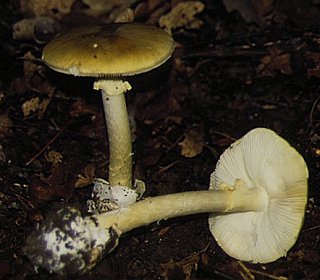
|
Death cap (Amanita phalloides). One of the most poisonous
fungi known. Although widespread in New Zealand, it is less
common than its better-known relation the fly agaric, A.
muscaria. Death cap usually grows beneath oak trees, and may
be increasing at present, as the fly agaric seems to be.
Death cap has a yellowish or greenish-white cap, so is
immediately recognisable from the more conspicuous fly
agaric. Both fungi have white gills and a volva(membrane) at
the base of the stem at ground level, this being a prominent
white cup in the death cap. Note: edible mush-rooms
(Agaricus species) do not have a volva or white gills.

Back to Top
|